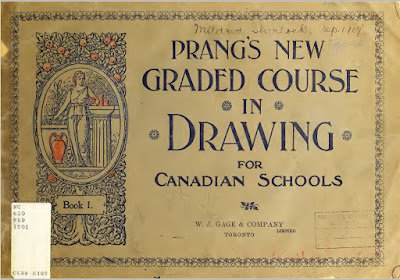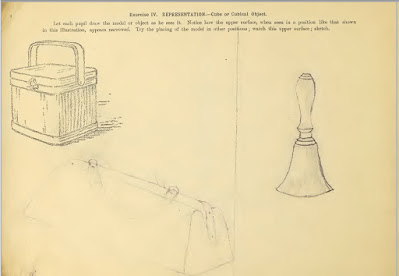In 1901, elementary schools taught drawing as a basic and necessary skill that everyone should practice. Here's an example of one of the popular drawing books: Prang's New Graded Course in Drawing.

A specific exercise written at the top of each page, with a small printed drawing as an example.
Let's look at one of the assignments. Note that "he" is used as the genderless inclusive pronoun.

"Exercise IV. REPRESENTATION.—Cube or Cubical Object.
Let each pupil draw the model or object as he sees it. Notice how the upper surface, when seen in a position like that shown in this illustration, appears narrowed. Try the placing of the model in other positions; watch this upper surface; sketch."
That's a helpful tip. They also have the student copy repeating patterns, focus on a bunch of grass, and build geometric study models from stiff paper. There's no talk of expression, personal creativity, or copying the styles of great artists of the past.
Instead, "Drawing is used as a means of training the eye and hand and as a language by
which the pupil not only expresses but impresses his thought."
Drawing is seen as a cognitive skill. In the Preface, the authors say that the "course of instruction presents a means of mental development indispensable in the education of every child."
But the writers of the book also recognize that drawing is not a purely objective activity. There's a personal dimension, too, that's an inevitable part of human visual perception.
Here's how they put it:
What a Picture is
"A true picture shows not only how an object or a group of objects appears, but it tells also something of the one who has drawn the picture. It tells how the objects looked to him ; it tells not only what he saw,_ but also what he thought about the objects. For whoever draws a picture indicates, or tries to indicate, in the drawing, what parts he cared for most."
Free download of Prang's New Graded Course in Drawing

Tragic no longer taught as a fundamental life skill; if not for drawing proper just seeing. And just maybe for that background people, as they mature (hopefully) and later in life, would rediscover something useful - to self and greater good of society - to do with their time.
ReplyDeleteI find some of the lesson interesting, such as teaching the child to touch the apple with a pencil to locate the size and angle of the edges, then refining the drawing after. Also the use of poetry throughout the book is wonderful.
ReplyDeleteI couldn't agree more, Colonel of Truth. Drawing has taught me to watch, observe, see, understand, appreciate our world in ways no other method ever has. I pity those that have never been introduced to drawing as a life tool. Drawing should be as common an activity as listening to music.
ReplyDeleteThere are some similarities in this book what to Juliette Aristides teaches in her drawing book which is my favorite newer book to use to teach kids.
ReplyDeleteThanks for sharing. It has given me more good ways to teach drawing.
The ability to accurately and objectively observe has become a lost art.
ReplyDeleteThis is so important to the ability to logically make decisions. If you look at the curriculum that was taught for 100's of years which was Greek, Latin, Grammer, and Literature (which was actually Public Speaking). Learning 2 languages is proven to expand the mind and ability to form concepts as each language comes from different viewpoints - just look at the meaning of BLUE in several languages especially Japanese and Latin. Grammer really does teach Logic too. And Literature, as studied and used by the Romans, was more about controlling/convincing a crowd as well as self understanding and control.
Nothing was about "Beauty for the sake of Art" or "self-expression".
The education system has lost so much and no one even seems to realize it. Sorry to get political but this isn't about Left or Right but I am some years older that you James, and we had so much more of the old system then. I remember learning to diagram sentences, which is a lost art but taught me so much about how the mind works.
I had a book once, forgot the name, but practiced not looking at the page but feeling the pencil touching the object as you drew the page. If anyone remembers the book/method perhaps they can explain the method better.
Thank you this is wonderful to be able to download.
ReplyDelete